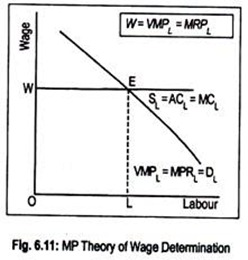The below mentioned article provides an overview on Marginal Productivity Theory of Wage Determination. After reading this article you will learn about: 1. Subject Matter of Marginal Productivity Theory of Wage 2. Assumptions of Marginal Productivity Theory of Wage 3. Limitations.
Subject Matter of Marginal Productivity Theory of Wage:
The marginal productivity theory of wage states that the price of labour, i.e., wage rate, is determined according to the marginal product of labour. This was stated by the neoclassical economists, especially J. B. Clark, in the late 1890s.
The term marginal product of labour is interpreted here in three ways: marginal physical product of labour (symbolized by MPPL), value of the marginal product of labour (symbolized by VMPL) and marginal revenue product of labour (symbolized by MRPL).
When marginal product of labour is expressed in money terms we obtain VMPL. MRPL is the change in total revenue following a change in the employment of labour. Marginal productivity theory of wage states that wage of labour equals VMPL (= MRPL). Employer will employ labour up to the point until market wage equals labour’s value of the marginal product (VMP) and marginal revenue product (MRP).
Assumptions of Marginal Productivity Theory of Wage:
ADVERTISEMENTS:
The important assumptions of this theory are:
i. Perfect competition prevails in products market and in labour market. Perfect competition in product market implies that products are homogeneous and the price of the goods is given for all firms in the market. Perfect competition in labour market also implies that labour as well as firms behave as ‘wage-takers’; no one can influence the wage rate.
Consequently, labour supply curve, SL, becomes perfectly elastic. Since wage rate does not change, labour supply curve incidentally, becomes the average cost curve of labour (ACL) and it coincides with the marginal cost curve of labour (MCL).
ii. Law of variable proportions operates.
ADVERTISEMENTS:
iii. The firm aims at profit-maximization.
iv. All labourers are homogeneous and are divisible.
v. Labour is mobile and is substitutable to capital and other inputs.
vi. Resources are fully employed.
ADVERTISEMENTS:
Wage rate will be determined by the interaction of demand and supply curves of labour in the market. Labour demand curve is explained by the VMPL curve. Since perfect competition exists in the product market, VMPL curve coincides with the MRPL curve. VMPL = MRPL curve is the firm’s demand curve for labour.
This curve slopes downward because of diminishing marginal returns. In Fig. 6.11, VMPL = MRPL = DL represents the firm’s demand curve for labour.
Further, as perfect competition exists in the labour market, the labour supply, SL = ACL = MCL, curve has been drawn perfectly elastic.
In Fig. 6.11, E is the equilibrium point since at this point labour demand equals labour supply. The equilibrium wage rate thus determined is OW. Corresponding to this wage rate, equilibrium level of employment is OL.
Note that for OL amount of labour, VMPL = MRPL is LE, which equals wage rate OW. At this going wage rate (i.e., OW) the employer will be maximizing profit by employing OL units of labour. However, less (more) labour will be employed if market wage rate rises above (falls below) OW.
Limitations of Marginal Productivity Theory of Wage:
This neo-classical theory of wage determination is subject to a large number of criticisms. Most of the criticisms of this theory are directed against the assumptions. Most of the assumptions are unrealistic.
The Main Criticisms are:
i. In the real world, perfect competition does not exist—both in the product market and in the labour market. Imperfect competition is found in all the markets. This theory, therefore, has limited applicability in the real world. If it is applied to the imperfectly competitive market, the workers will be subject to exploitation.
ADVERTISEMENTS:
ii. Labour can never be homogeneous— some may be skilled and some may be unskilled. Wage rate of a worker is greatly influenced by the quality of labour. A higher wage rate is enjoyed by the skilled labour compared to the unskilled labour. This simple logic has been totally ignored by the authors of this theory.
iii. Perfect mobility of labour is another unrealistic assumption. Mobility of labour may be restricted due to socio-political reasons.
iv. The marginal productivity theory of wage ignores the supply side of labour and concentrates only on the demand for labour. It is said that labour is demanded because labour is productive. But why labour is supplied cannot be answered in terms of this theory.
This is because of the fact that, at a given wage rate, any amount of labour is supplied. But we know that higher the wage rate, higher is the supply of labour. This positive wage-labour supply relationship has been ignored by the makers of this theory.
ADVERTISEMENTS:
v. Full employment of resources is another unrealistic assumption.
vi. This theory, in fact, is not a wage theory but a theory of employment. Wage rate is predetermined. At the given wage rate OW, how many units of labour are supplied can be known from this theory. In this sense, it is a theory of employment and not a theory of wages.
vii. Finally, this theory ignores the usefulness of trade union in wage determination. Trade union, through its collective bargaining power, also influences wage rate in favour of the members of the organization.
In view of all these criticisms, the marginal productivity theory of wages has become useless.
